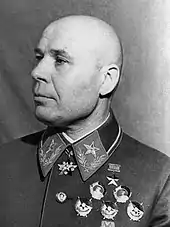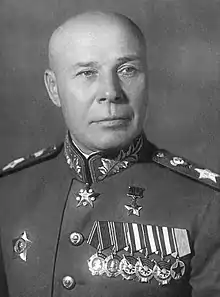Semyon Timoshenko
Semyon Konstantinovich Timoshenko (Russian: Семён Константи́нович Тимоше́нко, Semën Konstantinovič Timošenko; Ukrainian: Семе́н Костянти́нович Тимоше́нко, Semen Kostiantynovych Tymoshenko) (18 February [O.S. 6 February] 1895 – 31 March 1970) was a Soviet military commander and Marshal of the Soviet Union.
Early life
Timoshenko was born in a family of Ukrainian ethnicity[1] in the village of Orman, Russia's Bessarabia Governorate (present-day Furmanivka in Odessa Oblast, Ukraine).[2]
Military career
First World War
In 1914, he was drafted into the army of the Russian Empire and served as a cavalryman on Russia's western front. On the outbreak of the Russian Revolution in 1917, he sided with the Bolsheviks, joining the Red Army in 1918[3] and the Russian Communist Party (Bolsheviks) in 1919.[4]
The Russian Civil War
During the Russian Civil War, Timoshenko fought on various fronts. His most important encounter occurred at Tsaritsyn (later renamed Stalingrad), where he commanded a cavalry regiment, and met and befriended Joseph Stalin, who was responsible for the city's defense.[3] This connection would ensure his rapid advancement after Stalin gained control of the Communist Party by the end of the 1920s. In 1920–1921, Timoshenko served under Semyon Budyonny and Kliment Voroshilov in the 1st Cavalry Army; Budyonny and Voroshilov became the core of the "Cavalry Army clique" which, under Stalin's patronage, would dominate the Red Army for many years.[5]
Timoshenko fought against Polish forces in Kiev and then against Pyotr Wrangel's White Army and Nestor Makhno's Black Army.[1]
The 1930s
By the end of the Civil and Polish–Soviet Wars, Timoshenko had become the commander of the Red Army cavalry forces. Thereafter, under Stalin, he became Red Army commander in Byelorussia (1933); in Kiev (1935); in the northern Caucasus and then Kharkov (1937); and Kiev again (1938). In 1939, he was given command of the entire western border region and led the Ukrainian Front during the Soviet invasion of eastern Poland. He also became a member of the Communist Party's Central Committee. Due to being a loyal friend of Stalin, Timoshenko survived the Great Purge to become the Red Army's senior professional soldier.
The Winter War
In January 1940, Timoshenko took charge of the Soviet armies fighting Finland in the Soviet-Finnish War. This had begun the previous November, under the disastrous command of Kliment Voroshilov. Under Timoshenko's leadership, the Soviets succeeded in breaking through the Finnish Mannerheim Line on the Karelian Isthmus, prompting Finland to sue for peace in March. His reputation increased, Timoshenko was made the People's Commissar for Defence and a Marshal of the Soviet Union in May, replacing Stalin's crony Marshal Voroshilov as the Minister of Defence.
British historian John Erickson has written:
Although by no means a military intellectual, Timoshenko had at least passed through the higher command courses of the Red Army and was a fully trained 'commander-commissar'. During the critical period of the military purge, Stalin had used Timoshenko as a military district commander who could hold key appointments while their incumbents were liquidated or exiled.[6]
Timoshenko was a competent but traditionalist military commander who nonetheless saw the urgent need to modernise the Red Army if, as expected, it was to fight a war against Nazi Germany. Overcoming the opposition of other more conservative leaders, he undertook the mechanisation of the Red Army and the production of more tanks.[7] He also reintroduced much of the traditional harsh discipline of the Tsarist Russian Army.
In June 1940, Timoshenko ordered the formation of the Baltic Military District in the occupied Baltic states.
World War II

Following the German invasion of the Soviet Union, Timoshenko was named chairman of Stavka, the Soviet Armed Forces High Command, on 23 June 1941.[8] In July 1941, Stalin replaced Timoshenko as Defense Commissar and Stavka's chairman before sending him to the Central Front and Western Front[3] to supervise a fighting retreat from the border to Smolensk. In September, he was transferred to the Ukraine to replace Budyonny and restore order in the Southwestern Front at the gates of Kiev. On 23 October, the Soviets made Timoshenko command the entire southern half of the Eastern Front and Georgy Zhukov command the northern half.[9] In November and December 1941 Timoshenko organized major counter offensives in the Rostov region, as well as carving a bridgehead into German defenses south of Kharkov in January 1942.[3]
In May 1942, Timoshenko, with 640,000 men, launched a counter-offensive (the Second Battle of Kharkov) which was the first Soviet attempt to gain initiative in the springtime war. After initial Soviet successes, the Germans struck back at Timoshenko's exposed southern flank, halting the offensive, encircling Timoshenko's armies, and turning the battle into a major Soviet defeat.
General Georgy Zhukov's success in defending Moscow during December 1941 had persuaded Stalin that he was a better commander than Timoshenko. Stalin replaced Timoshenko as Commander of the Stalingrad Front on 22 July, with Vasily Gordov due to his failures up to that point in the war,[10] making him Chairman of the High Command. He was called back into service as overall commander of the Northwestern Front between October 1942 and March 1943.[11]
In 1945, Timoshenko attended the Yalta Conference. A rumor started in the western press that Stalin had attacked Timoshenko, but was later disproved. Damon Runyon commented in his short essay ‘Forceful Remarks’:
“I am disappointed to learn that Joseph Stalin did not pat Marshal Semën Timoshenko on the pimple or head, with a vodka bottle. To tell you the truth, I did not even know Stalin was supposed to have done the patting until I read a denial. The story had been going the rounds that Tim O'Shenko, as the Irish called him, arising to make a speech after many toasts had been drunk at a banquet at Teheran, gabbed so much that Stalin let him have it over the onion, or head, with a vodka bottle. My disappointment is not in the fact that Tim was not beaned in the manner described. Not at all. If any generals are to be beaned at all, I know of several I would prefer seeing used for that purpose. But the idea of saluting a windy speaker in this manner appeals to me greatly and I feel that it is a pity Stalin did not set the fashion, as reported.”
Between 15 August 1945 and 15 September 1945, Marshal Timoshenko traveled alone to review the Starye Dorogi displaced persons camp where Auschwitz concentration camp survivors recuperated after their liberation. Later author Primo Levi (Prisoner 174517) wrote in The Truce, how the extremely tall Timoshenko "unfolded himself from a tiny Fiat 500A Topolino" to announce the liberated survivors would soon begin their final journey home.[12]
Postwar
After the war, Timoshenko was reappointed commander of the Baranovichi Military District (Byelorussian Military District since March 1946), then of the South Urals Military District (June 1946); and then the Byelorussian Military District once again (March 1949). In 1960, he was appointed Inspector-General of the Defence Ministry, a largely honorary post. From 1961 he chaired the State Committee for War Veterans. He died in Moscow in 1970.
Awards
Russian Empire
| Cross of St. George, 2nd, 3rd and 4th class | |
Soviet Union
- Honorary revolutionary weapon—a sword with a nominal Order of the Red Banner (28 November 1920)
Foreign awards
| Order of the Tudor Vladimirescu, 1st class (Romania) | |
| Military Order of the White Lion "For Victory" (Czechoslovakia) | |
| Golden Order of the Partisan Star (Yugoslavia) | |
| Medal "30 Years of Victory in the Khalkhin-Gol" (Mongolia) | |
References
Citations
- Wojciech Roszkowski, Jan Kofman (2016). "Biographical Dictionary of Central and Eastern Europe in the Twentieth Century". p.1030. ISBN 1317475941
- Маршал Тимошенко: непростой и противоречивый жизненный путь. grad.ua
- Glantz & House 2009, p. 41.
- Axelrod & Kingston 2007, p. 813.
- Erickson Vol 1 1999, p. 15.
- Erickson 1999, pp. 96, 107.
- Neidell, Indy; Olsson, Spartacus (13 June 2020). "Finland and France Join Hitler - WW2 - 094 - June 13 1941". YouTube. TimeGhost History. Retrieved 14 June 2020.
- Earl Frederick Ziemke; Magna E. Bauer (1987). Moscow to Stalingrad. Government Printing Office. p. 24. ISBN 978-0-16-080081-8.
- https://www.youtube.com/watch?v=CjN6aybNbsQ&t=631s
- https://www.youtube.com/watch?v=YAfo5mse-ag&t=911s
- Generals.dk
- Primo Levi, If This Is a Man—The Truce (Abacus, 2013), p. 350.
- http://warheroes.ru/hero/hero.asp?Hero_id=896. Missing or empty
|title=(help)
General sources
- Axelrod, Alan; Kingston, Jack A. (2007). Encyclopedia of World War II. Volume 1. H W Fowler. ISBN 978-0-8160-6022-1.
- Erickson, John (1999). The Road to Stalingrad: Stalin's War with Germany. Volume 1. Yale University Press. ISBN 0-300-07812-9.CS1 maint: ref=harv (link) (1975, 2003)
- Glantz, David M.; House, Jonathan (2009). To the Gates of Stalingrad: Soviet-German Combat Operations, April–August 1942. Lawrence, Kansas: University Press of Kansas. ISBN 978-0-7006-1630-5.
External links
| Wikiquote has quotations related to: Semyon Timoshenko |
| Wikimedia Commons has media related to Semyon Timoshenko. |
| Military offices | ||
|---|---|---|
| Preceded by Ivan Fedko |
Commander of the Kiev Military District 1938–1940 |
Succeeded by Georgy Zhukov |
| Preceded by Kirill Meretskov as Commander of the Leningrad Military District |
Commander of the Northwestern Front 1940 |
Succeeded by Mikhail Kirponos as Commander of the Leningrad Military District |
| Preceded by - |
Chairman of the Soviet Armed Forces High Command 1941 |
Succeeded by Joseph Stalin |
| Political offices | ||
| Preceded by Kliment Voroshilov |
People's Commissar of Defense 1940–1941 |
Succeeded by Joseph Stalin |

